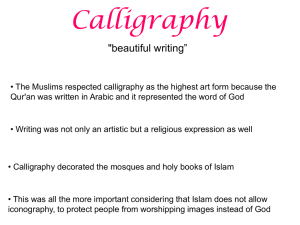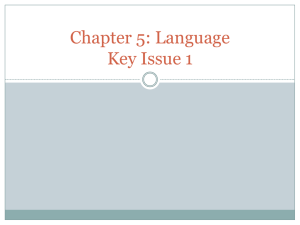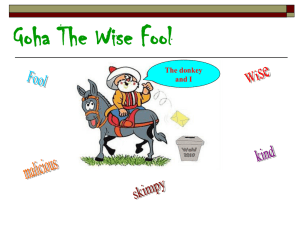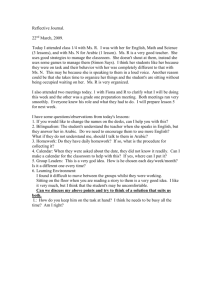Origin The Arabic script evolved from the Nabataean Aramaic script
advertisement
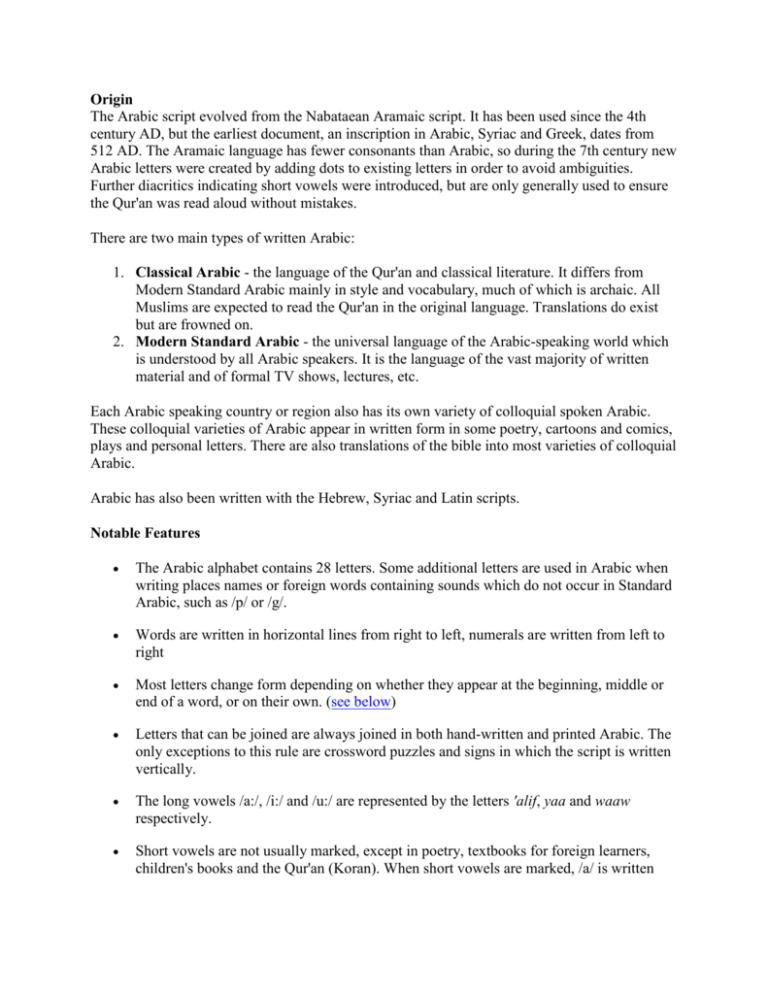
Origin The Arabic script evolved from the Nabataean Aramaic script. It has been used since the 4th century AD, but the earliest document, an inscription in Arabic, Syriac and Greek, dates from 512 AD. The Aramaic language has fewer consonants than Arabic, so during the 7th century new Arabic letters were created by adding dots to existing letters in order to avoid ambiguities. Further diacritics indicating short vowels were introduced, but are only generally used to ensure the Qur'an was read aloud without mistakes. There are two main types of written Arabic: 1. Classical Arabic - the language of the Qur'an and classical literature. It differs from Modern Standard Arabic mainly in style and vocabulary, much of which is archaic. All Muslims are expected to read the Qur'an in the original language. Translations do exist but are frowned on. 2. Modern Standard Arabic - the universal language of the Arabic-speaking world which is understood by all Arabic speakers. It is the language of the vast majority of written material and of formal TV shows, lectures, etc. Each Arabic speaking country or region also has its own variety of colloquial spoken Arabic. These colloquial varieties of Arabic appear in written form in some poetry, cartoons and comics, plays and personal letters. There are also translations of the bible into most varieties of colloquial Arabic. Arabic has also been written with the Hebrew, Syriac and Latin scripts. Notable Features The Arabic alphabet contains 28 letters. Some additional letters are used in Arabic when writing places names or foreign words containing sounds which do not occur in Standard Arabic, such as /p/ or /g/. Words are written in horizontal lines from right to left, numerals are written from left to right Most letters change form depending on whether they appear at the beginning, middle or end of a word, or on their own. (see below) Letters that can be joined are always joined in both hand-written and printed Arabic. The only exceptions to this rule are crossword puzzles and signs in which the script is written vertically. The long vowels /a:/, /i:/ and /u:/ are represented by the letters 'alif, yaa and waaw respectively. Short vowels are not usually marked, except in poetry, textbooks for foreign learners, children's books and the Qur'an (Koran). When short vowels are marked, /a/ is written with a horizontal line (fat’haa) over the consonant letter, /i/ is written with a horizontal line (kasraa) below the consonant letter, and a little hook (damnaa) is used to write /u/. A shadda, which looks like the letter siin without its tail, is used to indicate the doubling of a consonant. A small circle (sukuun) is used to indicate the absence of a vowel. Arabic consonants Arabic vowels The short vowels (a, i, u) and the diacritics attached to the long vowels are usually written only in poetry, textbooks for foreign learners, children's books and the Qur'an (Koran) Numerals with number names in Standard Arabic The Arabic language Arabic is a Semitic language with about 221 million speakers in Afghanistan, Algeria, Bahrain, Chad, Cyprus, Djibouti, Egypt, Eritrea, Iran, Iraq, Israel, Jordan, Kenya, Kuwait, Lebannon, Libya, Mali, Mauritania, Morocco, Niger, Oman, Palestinian West Bank & Gaza, Qatar, Saudi Arabia, Sudan, Syria, Tajikistan, Tanzania, Tunisia, Turkey, UAE, Uzbekistan and Yemen There are over 30 different varieties of colloquial Arabic which include: Egyptian - spoken by about 46 million people in Egypt and perhaps the most widely understood variety, thanks to the popularity of Egyptian-made films and TV shows Algerian - spoken by about 22 million people in Algeria Moroccan/Maghrebi - spoken in Morocco by about 19.5 million people Sudanese - spoken in Sudan by about 19 million people Saidi - spoken by about 19 million people in Egpyt North Levantine - spoken in Lebannon and Syria by about 15 million people Mesopotamian - spoken by about 14 million people in Iraq, Iran and Syria Najdi - spoken in Saudi Arabia, Iraq, Jordan and Syria by about 10 million people For a full list of all varieties of colloquial Arabic click here (Format: Excel, 20K). Source: www.ethnologue.com Sample Arabic text Translation All human beings are born free and equal in dignity and rights. They are endowed with reason and conscience and should act towards one another in a spirit of brotherhood. (Article 1 of the Universal Declaration of Human Rights)
